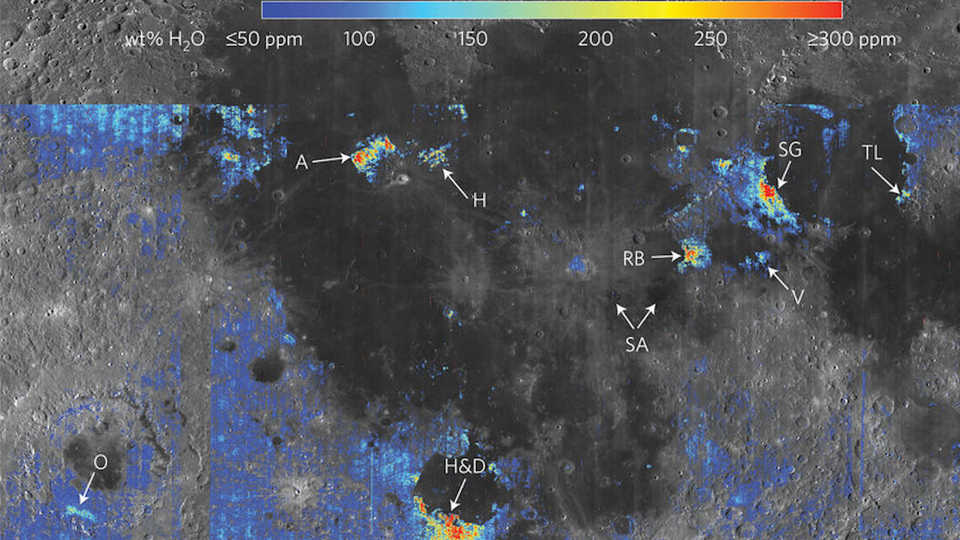Each month, renowned astronomers share their latest research at Morrison Planetarium.
Universe Update
How Much Water on the Moon?

Numerous locations of increased water content (arrows) are associated with previously recognized pyroclastic deposits. Nature.com
Scientists have been studying the Moon for decades but it wasn’t until 2008 that we began to understand that our fair satellite contains water, just like Earth. Since then, more and more evidence has emerged that the Moon doesn't just hold a little water here and there. Its mantle potentially holds as much water as our planet does, according to a new study published today.
The first finding of water on the Moon was thanks to samples of volcanic glass beads brought back to Earth from the Apollo 15 and 17 missions to the Moon. In 2011, further study of tiny crystalline formations within those beads revealed that they actually contain similar amounts of water as some basalts on Earth.
But still, questions remained, says Brown University’s Ralph Milliken. “The key question is whether those Apollo samples represent the bulk conditions of the lunar interior or instead represent unusual or perhaps anomalous water-rich regions within an otherwise ‘dry’ mantle.”
So Milliken and colleague Shuai Li took to the skies—satellite data, that is. But detecting the water content of lunar volcanic deposits using orbital instruments is no easy task. Orbital spectrometers measure the light that bounces off a planetary surface. By looking at which wavelengths of light are absorbed or reflected by the surface, scientists can get an idea of which minerals and other compounds are present.
The problem is that the lunar surface heats up over the course of a day, especially at the latitudes where these pyroclastic deposits are located. That means that in addition to the light reflected from the surface, the spectrometer also ends up measuring heat. “That thermally emitted radiation happens at the same wavelengths that we need to use to look for water,” Milliken explains. “So in order to say with any confidence that water is present, we first need to account for and remove the thermally emitted component.”
To do that, Milliken and Li used laboratory-based measurements of samples returned from the Apollo missions, combined with a detailed temperature profile of the areas of interest on the Moon’s surface. Using the new thermal correction, the team looked at data from the Moon Mineralogy Mapper, an imaging spectrometer that flew aboard India’s Chandrayaan-1 lunar orbiter.
The researchers found evidence of water in nearly all of the large pyroclastic deposits that had been previously mapped across the Moon's surface, including deposits near the Apollo 15 and 17 landing sites where the water-bearing glass bead samples were collected.
“The distribution of these water-rich deposits is the key thing,” Milliken says. “They’re spread across the surface, which tells us that the water found in the Apollo samples isn't a one-off. Lunar pyroclastics seem to be universally water-rich, which suggests the same may be true of the mantle.”
Their findings are published today in Nature Geoscience.
The idea that the interior of the Moon is water-rich raises interesting questions about its formation. Scientists think the Moon formed from debris left behind after an object about the size of Mars slammed into the Earth very early in Solar System history. One of the reasons scientists had assumed the Moon’s interior should be dry is that it seems unlikely that any of the hydrogen needed to form water could have survived the heat of that impact.
“The growing evidence for water inside the Moon suggest that water did somehow survive, or that it was brought in shortly after the impact by asteroids or comets before the Moon had completely solidified,” Li says. "The exact origin of water in the lunar interior is still a big question.”
In addition to shedding light on the water story in the early Solar System, the research could also have implications for future lunar exploration. The volcanic beads don't contain a lot of water—about .05 percent by weight, the researchers say—but the deposits are large, and the water could potentially be extracted.
“Other studies have suggested the presence of water ice in shadowed regions at the lunar poles, but the pyroclastic deposits are at locations that may be easier to access,” Li explains. “Anything that helps save future lunar explorers from having to bring lots of water from home is a big step forward, and our results suggest a new alternative.”